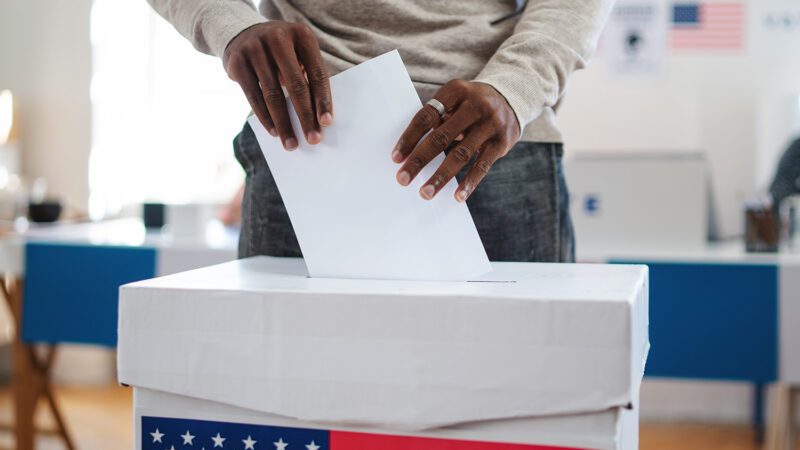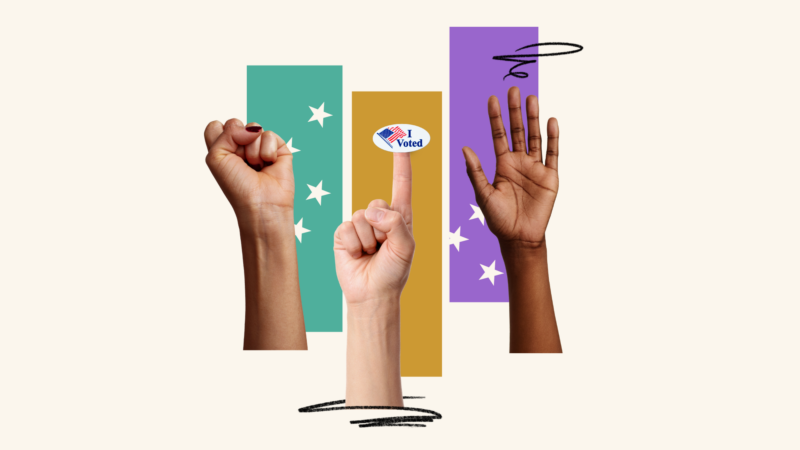Proportional representation, explained
- December 5, 2023
How our electoral system shapes our politics
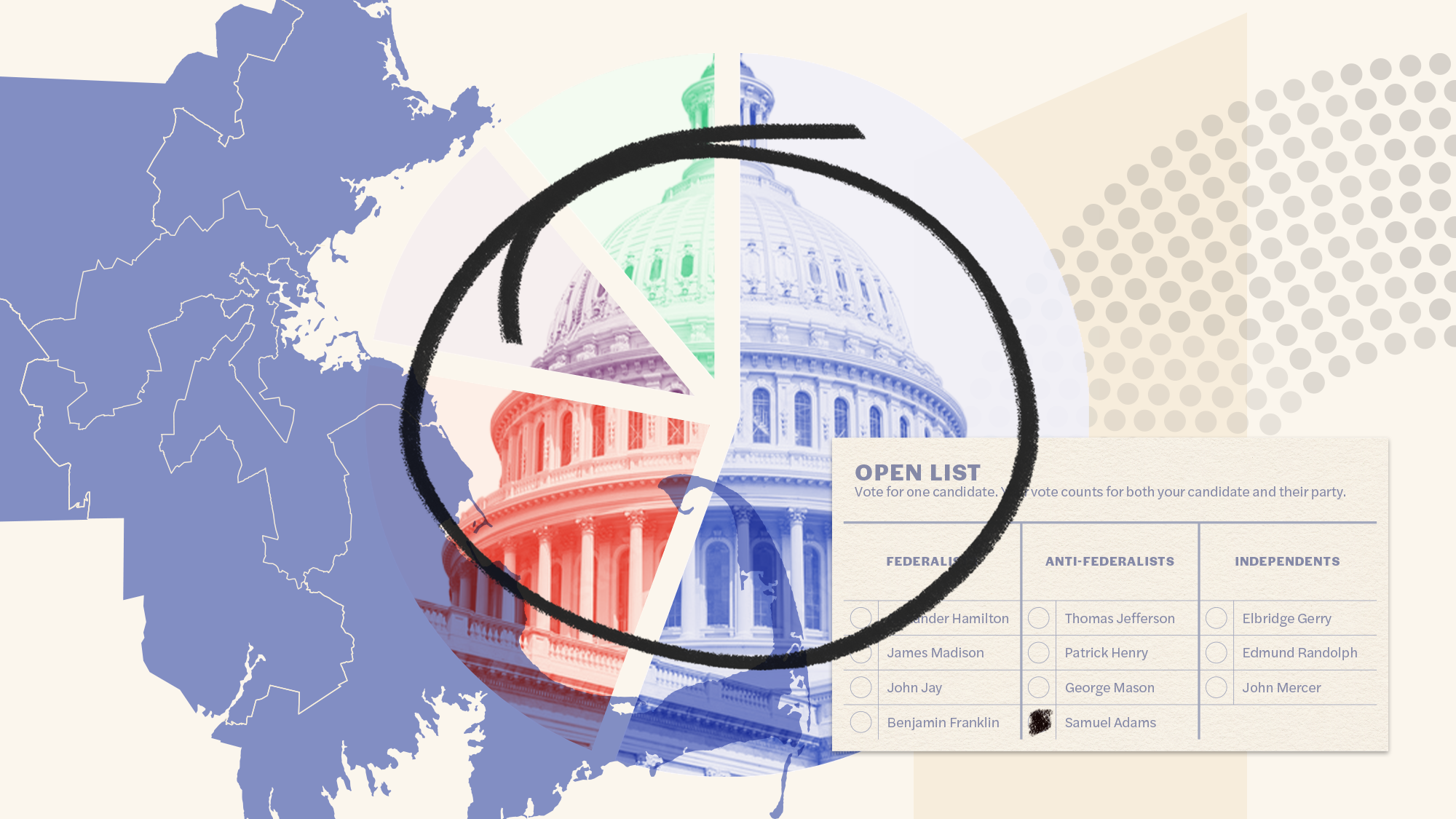
Proportional representation is an electoral system that elects multiple representatives in each district in proportion to the number of people who vote for them. If one third of voters back a political party, the party’s candidates win roughly one-third of the seats. Today, proportional representation is the most common electoral system among the world’s democracies.
How is this different from what the United States uses?

Want more Democracy Insights?Subscribe to our weekly newsletter
Every American today lives in a district that elects a single representative for congressional and most state legislative elections. Voters cast a vote for a candidate, one candidate wins, and all the others lose. This makes our elections “winner-take-all” — if a candidate wins 51 percent of the vote, she wins 100 percent of the representation. Any voters who did not back the winning candidate are not represented in government by a candidate for whom they voted.
Read more: How open are Americans to electoral system reform? Read more: How open are Americans to electoral system reform?
In contrast, proportional representation uses multi-seat districts with representation allocated in proportion to votes. For example, in a six-seat district, if a party’s candidates win 51 percent of the vote, they would be expected to win three of the six seats — rather than 100 percent. Unlike with winner-take-all, under proportional representation, most groups tend to have at least one elected official representing their viewpoint in government.
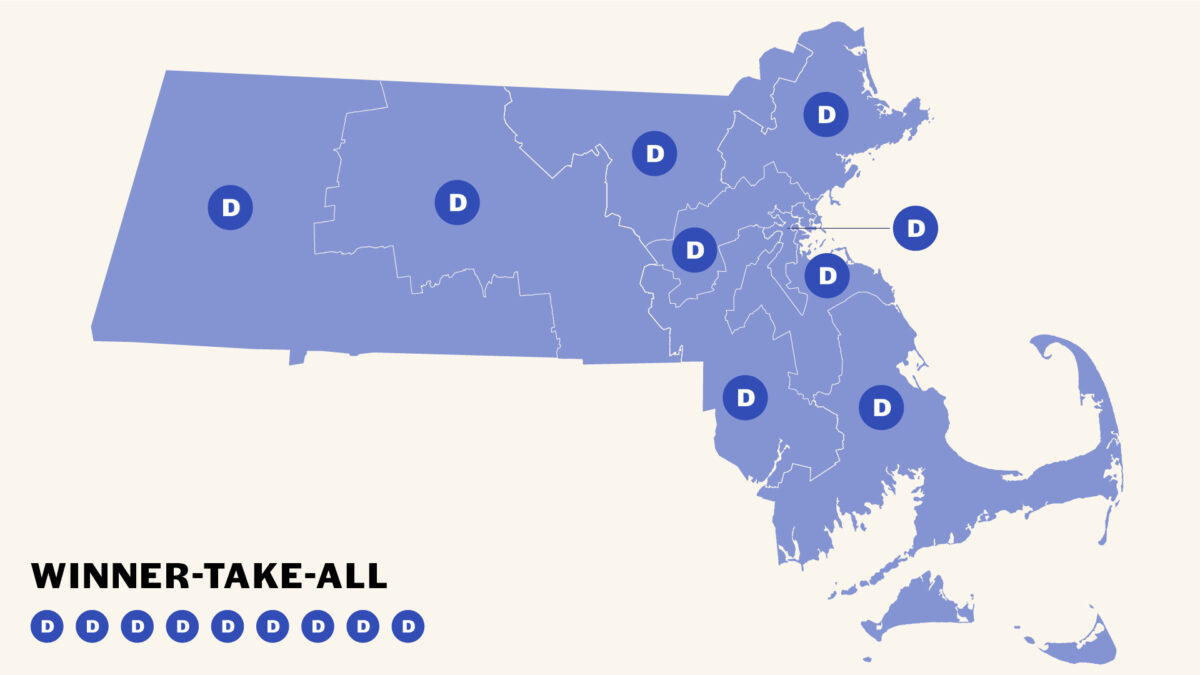
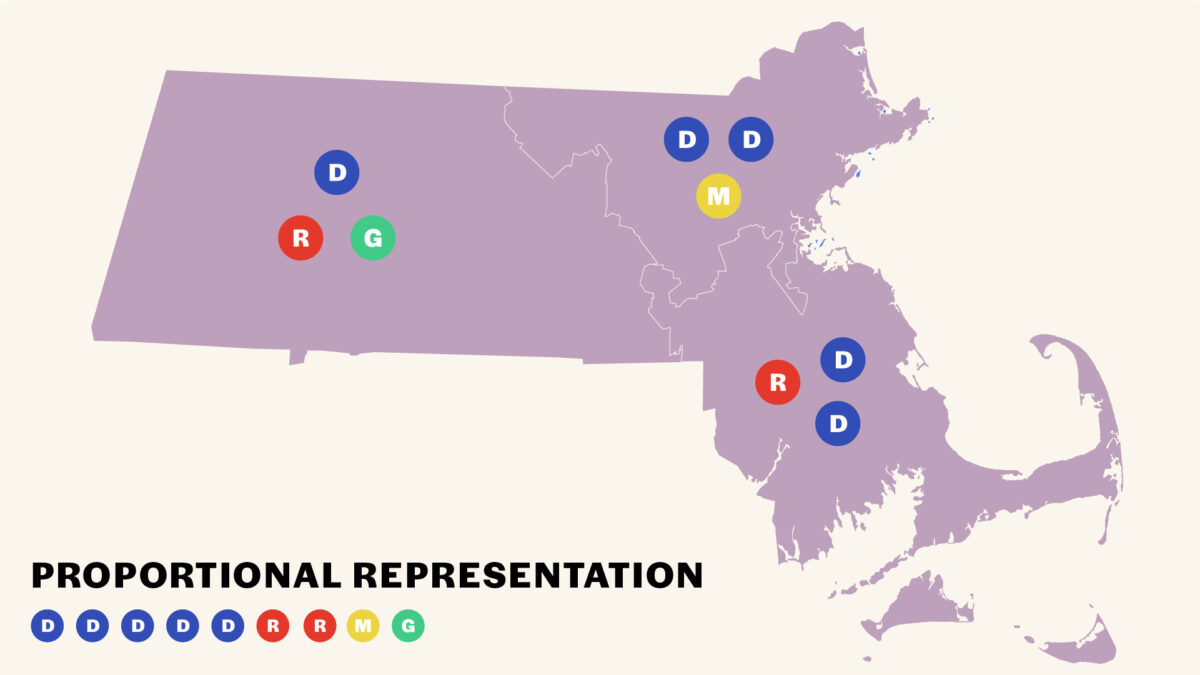
The problems with winner-take-all
According to scholarly research, winner-take-all elections are causing or aggravating some of the most pressing problems undermining American democracy. These include:
Researchers are especially concerned about the use of winner-take-all elections in highly polarized and diverse societies like the United States. As one global study of democratization concluded, “if any generalization about institutional design is sustainable,” it is that winner-take-all electoral systems “are ill-advised for countries with deep ethnic, regional, religious, or other emotional and polarizing divisions.”
‘[I]f any generalization about institutional design is sustainable,’ it is that winner-take-all electoral systems ‘are ill-advised for countries with deep ethnic, regional, religious, or other emotional and polarizing divisions.’
Larry Diamond, Developing Democracy: Toward Consolidation
Potential benefits of
proportional representation
Varieties of Proportional Representation
Varieties of proportional representation
In practice, proportional representation comes in many different versions. Most fit into one of four categories.
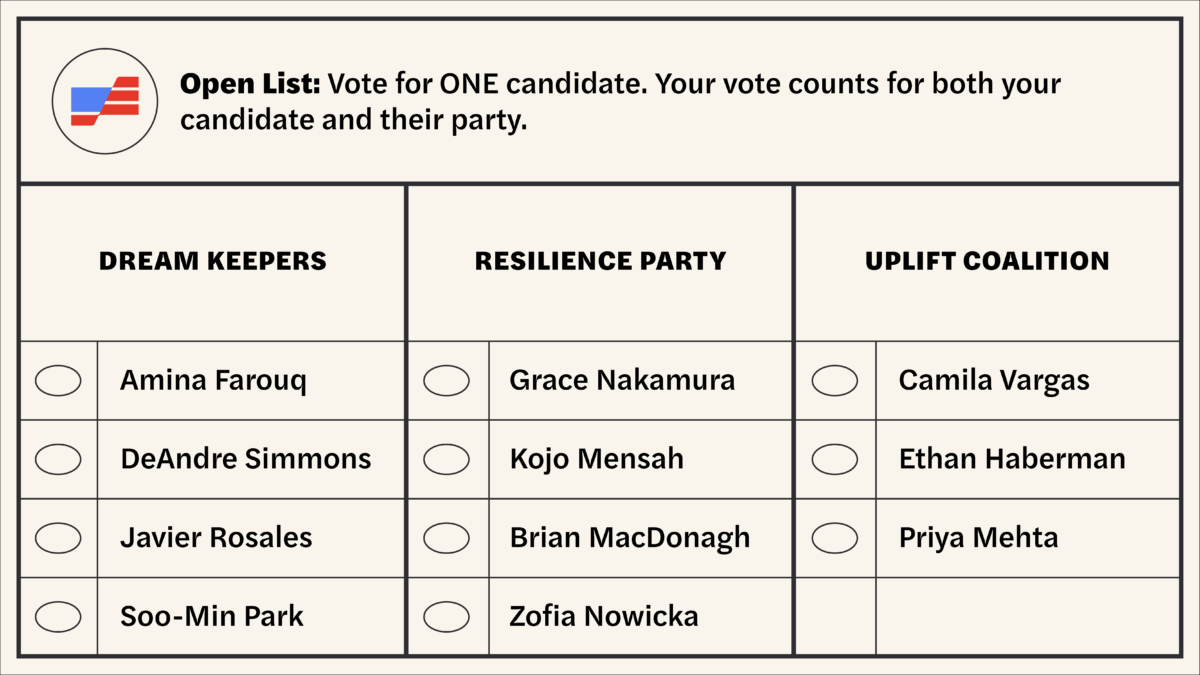
Open List
Think: Voting for a candidate and their party
In open list systems, each political party has a slate of candidates running for office (as in a primary election), and voters choose a candidate from one of the lists. Parties are allocated seats in proportion to the total number of votes their candidates receive, and the candidates who receive the most votes are elected. For example, a voter may select one Democrat from a list of Democrats running. In a six-seat district, if the Democrats together win 50 percent of the vote, the three Democratic candidates with the most votes are elected.
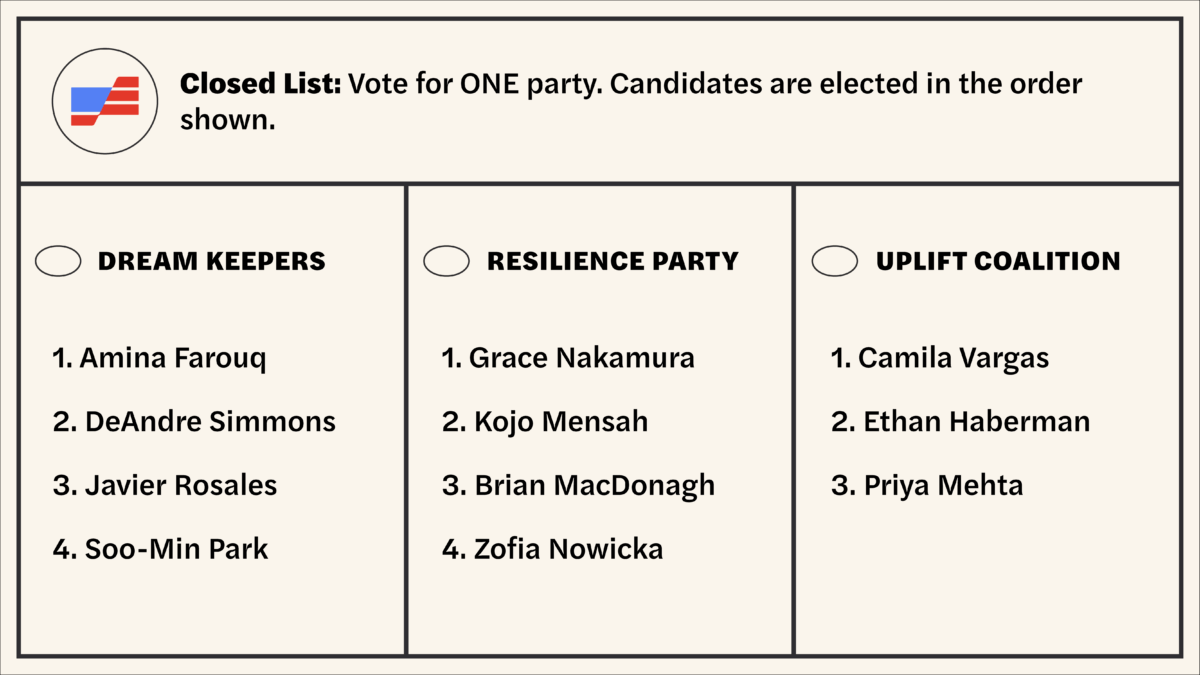
Closed List
Think: Voting for a party, not for a candidate
In closed list systems, voters select a political party on a ballot rather than an individual candidate. Parties are allocated seats in proportion to the votes they receive, and candidates are seated in the order determined by the party itself. For example, a voter may select the Republican Party on the ballot, but not an individual candidate. In a six-seat district, if Republicans win 50 percent of the vote, the party is allocated three seats, and the top-three candidates on the party’s list are elected.
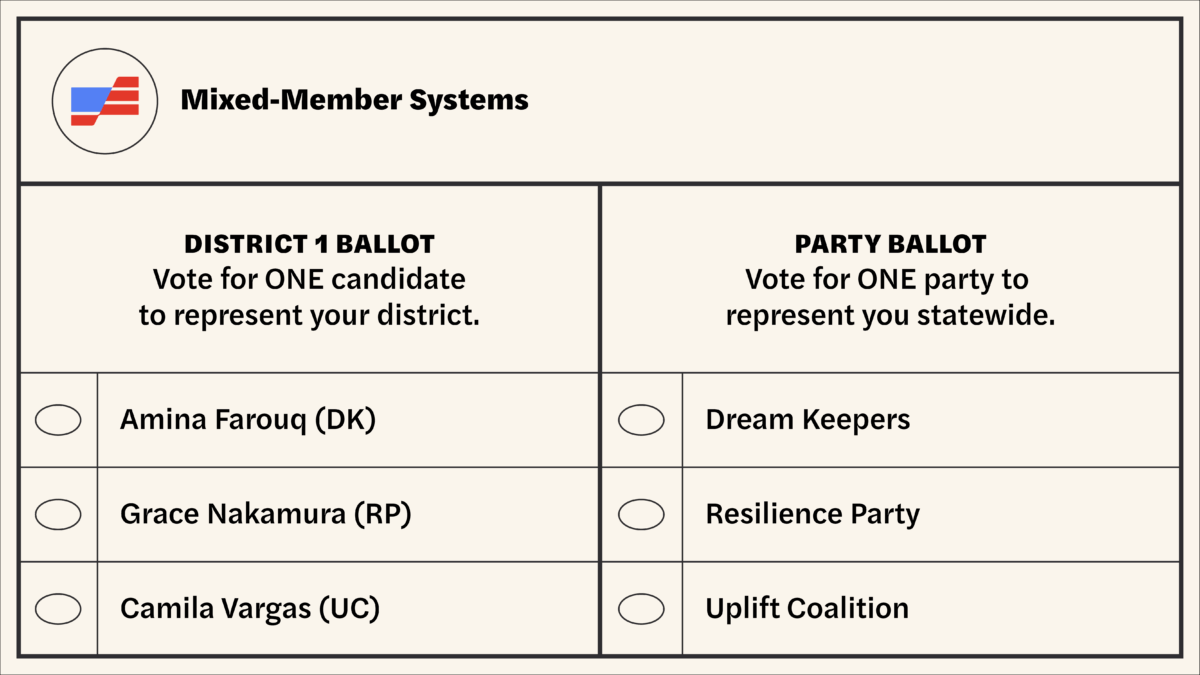
Mixed-Member Systems
Think: Proportional representation layered on top of single-member districts
Many countries use systems that blend components of winner-take-all and proportional representation, combining single-member districts with some number of additional seats allocated to parties proportionally. Voters make two choices: one for their single-winner district and one for a set of statewide seats allocated proportionally. For example, a given state could have three single-winner districts and three proportional seats. A party that gets 40% of the vote statewide could lose all three single-winner seats but still win one or two of the proportional seats.

Single Transferable Vote
Think: Ranking candidate choices across the ballot
Some countries use a system where voters rank candidates, regardless of their party, and the top-ranked candidates are elected. Through successive rounds of ballot counting, votes are reallocated to lower preferences as candidates are either elected or eliminated. This goes on until the seats are filled. For example, if a voter’s first choice candidate comes in last, the candidate is eliminated and the vote is reallocated to the voter’s next preference in the next round of counting. Additionally, if a candidate gets more than the amount of votes needed to win a seat, the additional votes are also reallocated to the voters’ lower preferences.
It is clear that our winner-take-all system — where each U.S. House district is represented by a single person — is fundamentally broken.
LETTER TO CONGRESS FROM 200+ POLITICAL SCIENTISTS, THE NEW YORK TIMES
Is proportional representation connected to ranked-choice voting?
Ranking candidates is a method of voting that is possible under both winner-take-all and proportional systems. While ranked-choice voting and proportional representation are compatible, they are also distinct reforms.
What about fusion voting?
Fusion voting, which allows multiple parties to nominate the same candidate and “fuse” their support, is distinct from proportional representation and generally is only used with single-member districts. However, the two reforms share many of the same goals, such as making it easier for more parties to form, permitting more options for voters, and enabling more fluid political coalitions.
Won’t more parties just lead to more gridlock and chaos?
While certain proportional systems are designed in a way that can generate dozens of parties (which can be destabilizing), most do not. Research finds that modest multiparty activity can lead to more effective governance, while two polarized parties can lead to dangerous levels of gridlock, as well as destabilizing change from one government to the next.
How can this be implemented in Congress?
Adopting proportional representation for the U.S. House is possible through regular lawmaking. Congress could implement proportional representation, or rather, give states the ability to experiment with different versions, through legislation alone. No constitutional amendment is needed.
Can proportional representation work in a presidential system?
Proportional representation is just as common in countries with presidential systems as it is in countries with parliamentary systems. In fact, presidential systems are more likely to use proportional representation for their legislatures, while combining presidentialism with winner-take-all is a rarity found only in four countries (the U.S., Ghana, Liberia, and Sierra Leone).
What about state and local elections?
Any lawmaking body, from national and state legislatures to city councils and school boards, can be elected proportionally. Just like for Congress, implementing proportional representation in state legislatures could increase competition and representation and decrease polarization and antidemocratic extremism. But importantly, it could also encourage the de-nationalization of politics and a return to more localized concerns.
Is large-scale electoral system change politically possible?
While changing electoral systems is politically difficult, it is far from impossible. Indeed, most democracies around the world have changed their electoral systems at least once, if not more. Several notable examples of reform in recent decades — New Zealand, Japan, and others — help illustrate how change can happen.
How would proportional representation work with the Voting Rights Act?
As long as proportional representation leads to minority representation that is as equivalent or better than winner-take-all outcomes, it is compatible with existing voting rights law. And in most cases, it expands the possibilities for minority representation beyond what is possible under winner-take-all rules.
How does proportional representation fix gerrymandering?
The more seats a district has, the harder that district is to gerrymander. Most multi-winner districts are functionally impossible to manipulate for partisan gain. With a lower threshold required to win each seat, voters can no longer be predictably “cracked” between districts or “packed” into one district with any real effect.
How would proportional representation impact constituent services?
We don’t know for sure. However, all voters are, today, already serviced by three legislators: a congressperson and two senators. Research finds that constituent services may improve, as representatives compete with each other to provide better service and voters can select and engage with representatives who best represent their community and interests. Under proportional representation, most voters could contact a representative for whom they voted.
Related Content
It can happen here.
We can stop it.
Defeating authoritarianism is going to take all of us. Everyone and every institution has a role to play. Together, we can protect democracy.
Donate
Sign Up for Updates Sign Up for Updates
Explore Careers Explore Careers
How to Protect Democracy How to Protect Democracy
